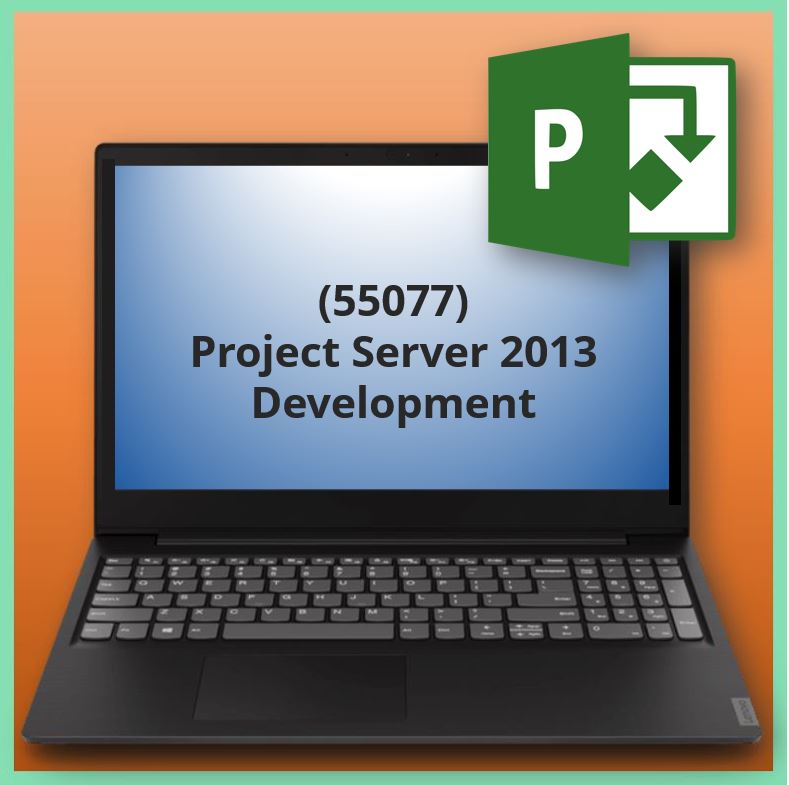Aangeboden leervormen

Project Server 2013 Development (55077)
Course Description
This course will show students how to develop application using the various APIs available in Project Server including Project Server Interface (PSI), .NET Client Side Object Model, JavaScript Object Model and REST. In addition, you will learn how to extend on-premise Project Server installs via web parts, local and remote event handlers, Apps via the new App Model and workflows.
At Course Completion
After completing this course, students will be able to:
· Develop applications for Project Server using PSI and CSOM.
· Develop and create Project Server workflows.

Voor wie
This course is intended for anyone that needs to build applications that leverage Project Server 2013.
Programma
Module 1: Overview
A simple introduction module.
Module 2: Project Server Introduction
In this module you will be introduced to Project Server 2013 features and architecture and a brief review of the Microsoft Enterprise Project Management (EPM) stack.
Lessons
· Introduction
· Architecture
· Development Basics
Lab : Installing Project Server 2013
· Create a Project Web App Site
After completing this module, students will be able to:
· Understand the Microsoft EPM solution stack
· Describe the new features of Project Server 2013
· Describe the architecture of Project Server 2013
· How to install Project Server 2013
· How to setup and configure a Project Web App site
Module 3: Project Service Interface (PSI)
Description: In this module you will learn about Project Server Interface (PSI). Each of the PSI ASMX and WCF interfaces will be explored and you will learn how to use these endpoints in your own applications.
Lessons
· Project Server Interface
Lab : Creating a PSI Proxy
· Exploring PSI
· Creating a PSI Proxy
· Creating simple applications with PSI
Lab : Programming with PSI
· Programming with PSI
· Working with Projects
· Working with the Queue System
· Working with Resources
· Working with Tasks
Lab : Implementing Impersonation
· Implementing Impersonation with PSI
Lab : Using Windows PowerShell with PSI
· Run a Windows PowerShell Script to create a project
Lab : Creating a PSI Extension
· Create a PSI Extension
After completing this module, students will be able to:
· Describe Project Server Interface (PSI)
· Describe each PSI endpoint service
· Create updated PSI Proxy assemblies
· Build applications that create and modify various Project Server objects using PSI
· How to extend PSI with your own end points
Module 4: Client Side Object Model
In this module you explore the new .NET Client Side Object Model (CSOM) of Project and SharePoint Server and how it differs from developing with PSI.
Lessons
· Client Side Object Model
· JavaScript Object Model
Lab : Using Client Side Object Model
· Learn to work with Client Object Model (CSOM)
· Creating Projects
· Creating Tasks
· Creating Resources
· Creating Custom Fields
· Creating Lookup Tables
Lab : Using JavaScript Object Model
· Learn to work with JavaScript Object Model (JSOM)
· Creating Projects
· Creating Tasks
· Creating Resources
· Creating Custom Fields
· Creating Lookup Tables
After completing this module, students will be able to:
· Describe the .NET CSOM libraries
· How to create applications that use the CSOM
· How the CSOM formats and sends requests to Project Server and SharePoint
· How to debug CSOM calls using Fiddler
· Understand the CSOM message size limits
· Describe JavaScript Object Model (JSOM)
· How to use the JavaScript Object Model in applications
· Describe best practices when using JSOM
· Describe how to make cross-domain calls with the Cross Domain library
Module 5: REST API
In this module you will learn how to use the Project Server REST APIs in your applications. In addition, you will learn about the OData specification and how to format your REST urls to limit, sort and filter the returned data.
Lessons
· REST APIs
Lab : Programming with REST
· Working with REST
· Using LINQ with OData
· Working with OData Limits
· Working with OData Filters
· Creating Projects
· Creating Resources
· Creating Tasks
· Creating Custom Fields
· REST Authentication (Windows, Forms, O365)
After completing this module, students will be able to:
· Describe the Project Server REST API
· Describe how OData works with the REST API
· Use OData to filter your REST data
· Use REST to create, retrieve, update and delete Project Server objects
· Learn about useful tools to help aid your REST development
Module 6: Programming Project Server
In this module you explore how to develop and deploy various extensions to Project Server 2013. These include custom actions, Web Parts, and local and remote event receivers. Additionally you will learn to interact with the JS Grid control.
Lessons
· Extending Project Server UI
· Event Receivers
Lab : Adding Ribbon Actions and JSGrid Events
· Create a SharePoint Solution package
· Create and deploy custom actions
· Extend the JS Grid control events
Lab : Creating Event Handlers
· Create an Project entity Event handler
· Create an CustomField entity Event handler
· Deploy and test event handlers
· Debug event handlers
Lab : Remote Event Receivers
· Create a remote event receiver
· Deploy a remote event receiver
Lab : Creating Web Parts
· Create a PSI Extension
· Create a Project Web Part that uses JS Grid
· Deploy a Web Part Project
· Configure a Web Part
After completing this module, students will be able to:
· Extend Project Server with custom actions (ribbon and items)
· Understand the JS Grid control features and how to extend it
· Create and deploy Project Server web parts
· Create server event handlers
· Create remote event receivers
Module 7: Developing Reports
In this module you will learn about many of the Business Intelligence and Reporting features of Project Server 2013. This includes the default set of Excel Services Reports and how to use the more advanced reporting features like Analysis Services, PowerPivot and PerformancePoint.
Lessons
· Portfolio Analysis
· Business Intelligence Features
· Managing Reports
· Common Errors
Lab : Configure Business Intelligence
· Setup Report Authors and Report Viewers
· Configure SQL Server Login
· Install Analysis Services
· Install SQL Server AMO
· Configure Excel Services
· Configure Secure Store
· Configure PerformancePoint
Lab : Reports and Dashboards
· Working with Business Intelligence Center
· Exploring Project Server Database Tables
· Working with Sample Excel Reports
· Uploading Excel Report in the Project Site
· Creating Dashboard Reports
· Creating Excel Services Reports
· Creating PerformancePoint Reports
· Creating Reporting Services Reports
· Creating Analysis Services Reports
Lab : Managing Strategy Drivers
· Create Strategy Drivers
· Create Driver Prioritization
· Perform Portfolio Analyses
After completing this module, students will be able to:
· Describe the Business Intelligence and Reporting features of Project Server
· Describe the default reports in the ProjectBICenter site
· How to setup and use the Analysis Services feature
· How to create customized Reports and Dashboards
· How to use BI related web parts
· How to use Excel Services, PerformancePoint, Reporting Services and Analysis Services for reporting
Module 8: Developing Apps
In this module you explore how to create various types of Apps for Project and Project Server using the various APIs explored in the previous modules. You will also learn how to publish your Apps to the SharePoint App store for others to take advantages of. Additionally you will gain a deep understanding of the authentication models of Apps.
Lessons
· Developing Project Apps
· Project Server Apps
Lab : Creating Project Server SharePoint Hosted Apps
· Exploring Project Server Apps
· Creating and Configuring a Project Server App
· Exploring SP.AppContextSite
· Deploying a Project Server App
· Publishing a Project Server App
· Exploring SharePoint App Marketplace
Lab : Creating Project Task Pane Apps (Manual)
· Create a Project App
· Create a Simple Task Pane App
· Create an Advanced Task Pane App
Lab : Creating Project Task Pane Apps (Visual Studio)
· Create a Project Office App
Lab : Creating Provider Hosted Project Apps
· Create and deploy a Provider hosted App
· Working with High Trust and Low Trust
· Exploring Context Tokens
· Exploring Access Tokens
· Exploring Refresh Tokens
Lab : Using the SharePoint Web Proxy
· Using the SharePoint Web Proxy
Lab : Developing App Packages
· Creating an App Package
· Deploying an App Package
Lab : Creating Public SharePoint AppStore Apps
· Creating a Seller Dashboard account
· Create and Publish AppStore SharePoint App
After completing this module, students will be able to:
· Create Project Task Pane Apps
· Create SharePoint and Provider hosted Apps
· Describe how OAuth works with Apps
· Describe the difference between High and Low Trust Apps
· Describe the various deployment methods for Office and SharePoint Apps
· How to work with Project Server App Packaging
· Describe how to create and publish Apps to the SharePoint App Store
Module 9: TFS and Project Server Integration
In this module you will learn what TFS is and how it integrates with Project Server to manage development projects.
Lessons
· Team Foundation Server
· TFS and Project Server Integration
Lab : TFS and Project Server
· Install Team Foundation Server Extensions
· Configure Team Foundation Server integration
· Explore TFS and Project Server integration
After completing this module, students will be able to:
· Describe TFS and Project Server integration
· Install and configure TFS extensions for Project Server
· Manage project tasks with TFS and Project Server
Module 10: Developing Workflows
In this module you will learn how to work with SharePoint and Project Server workflows.
Lessons
· SharePoint Workflows
· Project Server Workflows
Lab : Creating Project Workflows (SP Designer)
· Create Project Detail Pages
· Create Workflow Stages
· Create and Assign Workflows
· Restart Workflows
Lab : Creating Project Workflows (Visual Studio)
· Create a Project Server Workflow using Visual Studio
After completing this module, students will be able to:
· Describe the Project Server workflow architecture
· Create Project Server workflows with SharePoint Designer
· Create Project Server workflows with Visual Studio
· Create workflow Stages and Phases
· Design a project approval workflow
Voorkennis
Understanding of Project Server basic concepts (projects, resources, tasks, assignments, etc), SharePoint navigation, and common web technologies like HTML, Javascript and JQuery. A firm understanding of .NET C# is also required.
Examen
NVT
Duur training
Open leercentrum: 5 dagen







